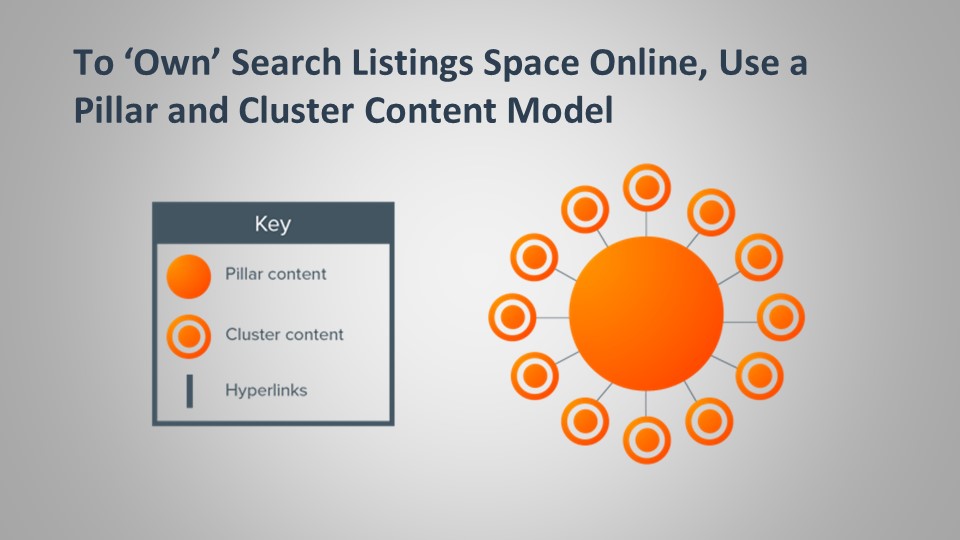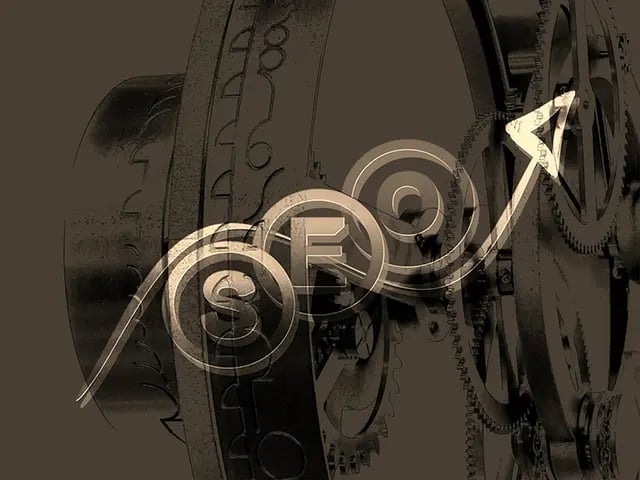Inbound Marketing Blueprint How To Build A Marketing Machine
- Home
- Inbound Marketing Blueprint How To Build A Marketing Machine
This is a transcript of a talk from HubSpot at the HubSpot User Group Meeting on 18th September 2019 in London.
I always enjoy hearing other people talk from the industry and it's quite fascinating. There are a couple of things that we're going to do just to finish off and the main presentation that I'm going to go through is called the Inbound Blueprint. It’s just stepping back and looking at the core fundamentals of:
- Why do we do what we do?
- How do we do it?
- How we can help?
I'm not inspired is not quite the right word. I'm talking about agencies. We tend not to wave our flag too much but I'm going to take an opportunity to do that here, if you'll forgive me.

We've been selected to appear in the parliamentary review. This is a Government body that looks across industries and the country. It looks at the state of the nation and Whitehat had been chosen. As an example of an outstanding company working in the digital agency and helping companies grow. So we're very proud of that. It's not that, the thing that I wanted to focus on is more just a side swipe. We've sort of managed to avoid the B word for most of the presentation and obviously, we're going to leverage this as much as we can and it's going to be turned into a press release but it's going to be done. There's quite a comprehensive article and You know me, what we do, all these kinds of things and the reason I'm saying this is, sometimes you've got to take the good with the bad and there's nothing bad about being referenced by the government. As you know, as a leader in your industry unless you see the person who's actually, promoting you we're happy to have the right honourable, Mr, Gove on our side. Take, that in whatever way you like and that's moving rapidly on. Yes. Brexit means Brexit. Of course, it does.
So let me just whizz through these opening ones because this is where we are. You know who we are. Inbound, you should kind of know what inbound is, an awful lot of HubSpot users are here, even though those who aren't HubSpot users have probably heard me rattle on about the Inbound Methodology. I think it's worth stepping back and looking at it. Figuring out:
- Why we do what we do
- How we can do it better
- What are the methodology and process around some of these things are
I had a conversation earlier over coffee and it reminded me of some statistics that HubSpot threw out the other the other day and Brian Halligan when he came and spoke, mentioned this.

The way that people buy has changed. It's fundamentally different than it was 10 years ago and most certainly than it was 15 to 20 years ago. Statistically, you can put numbers around this and it's quite simple to understand. It's not complicated. If you look back in time when people bought something, they would turn to an expert. That expert would be a salesperson and if you are buying a car, if you're buying a house, if you're buying a piece of enterprise-level software, you would go to the salesperson. The balance between Sales and Marketing was probably around 20% on the marketing side and about 80% or so, on the sales side and the salesman was the expert. He was the guide that you had to go to because he owned the knowledge. He had all the information, the price, the capabilities and all these things that you wanted to know about. It is owned by the sales guy.
“That's why we're stuck even now in the methodology or the mythology of sales”
If you think about that, that's why we're stuck even now in the methodology or the mythology of sales. If a company wants to grow, they still think, we better hire some more salespeople now and better invest in the sales team because that was the traditional way that you grew a company. Now if you look at the statistics, those numbers are reversed. Probably 70% of the time a buyer goes through their buyer's journey, the stages that they go through before they purchase from you. It is spent not talking to one of your salespeople or not talking to anybody in your organisation directly. So think about that in terms of budgets.
- Why then are companies spending so much money still on sales?
- Why is marketing still seen as not inferior but a lesser partner in that relationship?
How do I know how much to spend on marketing?
I think it's wrong and I think it's changing. It is changing, but slowly because it's difficult to move an oil tanker that's moving in a direction. It takes a while, but this is why marketing needs to fight for its corner. Because if you've got a budget plan to grow the business, I would say the bulk of that money should be spent on marketing. Marketing, my definition of marketing is something that generates sales-qualified leads. It does not have to be complicated and that's what marketing does. Marketing working with sales is a growth team and that's where we should all be heading. We had Dan Tyre here last year talking about Smarketing. Nobody ever uses that in the UK I let him say it anyway, but it's the way that we should be thinking. Those teams should be an amalgam.

Your teams should be working together and there should be service level agreements (SLA) between them. Let's step through this. The challenges that a client has when they talk to us when they hire a marketing person internally are:
- “I'm not getting enough leads”
- “I’m not getting enough traffic to my website”
- “My leads aren't moving down the funnel”
- “We're generating leads but they're kind of stuck”.
- “I have lots of content, but I'm not getting any business from that”.
- "It's not converting and I'm getting leads”
These are very common questions.
They're bad quality, if you do surveys and you look at the data, then you will see numbers where the marketing challenges are quite clear.
That really distills into these points. I'm not attracting the right traffic or enough traffic to the site. These are two different things, but essentially, there are not enough people coming to the site. It's not converting even. The ones that are turning into leads are not turning into customers. So, let's see if we can fix some of those things. It's sitting on top of the inbound methodology. I'm not attracting the right type of customer. Positioning and personas, these are really, really key. Positioning is often something that companies are quite bad at and we were quite guilty of this in early days of trying to be everything to everyone. If somebody would come to us and say, Clwyd, you know, we want to grow our dental practice, we want to grow our huge enterprise software business or we've got a corner shop.
Am I allowed to say no?
I would say, yeah, absolutely! We can help you with that. We deal with companies and grow the business but if you spread yourself too thin, if you ask for everything, you get nothing. You benefit more by being very clear about what your skills are, even what your weaknesses are and that comes back to the talk earlier on about a bad fit. If you're clear that a particular sector, a particular client or a particular environment is not good for you, don't be happy about signing up a new deal. It's so tempting. Learn to say NO but also learn to position yourself on your website so that it's clear what you do, who you can help and how you can help them. Those buyer personas that we're going to talk about are therefore going to be comfortable and are going to be attracted to you. If you're a marketing company, there are millions of marketing companies out there, but if you're a marketing company that specialises in:
- dealing with companies with a turnover of between two and five
- located in the UK
- specifically within the tech sector, maybe even the biotech sector
- with a small marketing team
- a large sales team
- and specific growth targets
then that's going to cut out a whole load of people, but it's actually going to attract the ones that you want to work with.
In our case, that probably describes Whitehat, so don't be afraid of sending people away. The best type of traffic is your ideal customer, not just any type of customer.
This comes back to quality again and you've probably heard me talk about this before. We're all guilty of sometimes as marketers being mediocre. What I call random acts of marketing, I need to produce a blog post and I've been tasked with producing four blog posts a month. Great! I've produced four blog posts a month but:
- Did it move the needle?
- Did it affect the business?
- Did it affect revenues?
- Did it hit the KPI targets that we're trying to work towards?
Rather than, I've completed my tasks for the month, agencies and individual marketers are guilty of that. You need to be clear especially if:
- You are a thought leader in your industry
- You have something to say
- You talk at conferences
- You are respected
That should be displayed on your website. It should be clear, you should have quotes, you should have references and you should have videos.

Lack of ambiguity is key. If you have unique selling points, you have things that you are specific and good at, then drill down onto them, double down on them and emphasise them. Personas sometimes get dismissed. It's that they're like the business plans that get created, thrown away and never looked at. We think personas and you've heard HubSpot rant on about personas for a long time, but they are practical tools and they're not something vague. The way I look at a persona and we go through a persona-building exercise with a client, we produce maybe a 40-page document on a particular persona and then go into it in a lot of depth, but within that, there are probably a few things that you need to drill down on again, it's not complicated.
What do I need to do?
What are the goals that these particular people have and what are the barriers that they have to achieving those goals that you can help them with? It's not much more complicated than that. What you then need to do typically is you'll have three personas that you'll work with initially, if you're starting up a campaign that's a pretty average number. It's a very good starting point. Three personas. You've got their buyer's journey. You need to look at, the steps that they go through, awareness, consideration, and decision. The different steps before they buy. So you've got those three steps, you've got three personas, that's nine! You then multiply that by all the problems and goals that each of them has and that might be 10. That's 90 pieces of content that you will need to write. That's your content strategy.
There you go! I created a content strategy for you. It's not hard. There's a great book and I'm going to quote it. I'll give you the actual reference at the end of this presentation by a guy called Marcus Sheridan who was the last speaker that I spoke with, spoke with and listened to, at inbound. He's a great speaker, but he also wrote a great book called “They Ask, You Answer” and the whole premise of that book is just that, listen to people, find out what problems they have and address those problems on your website with video, text and with all the different media sources that you can use. Doesn't need to be any more complicated than that.

- What keeps people awake at night?
- What are the difficult questions that you are uncomfortable about putting up on that site?
The classic one is the price. I can't possibly tell you how much our services cost we’re a value-based business, right? Clients would run away if I quoted a price. We're different from everybody else. You're not different from everybody else. It's the same problem. You need to talk about things and everybody has it. A pricing model. That might be variable, but you can talk about it. You can explain your methodology or your reason for what constitutes a large, medium or low engagement fee. People are going to find that information anyway and you think they don't know how much you charge. They will find out. They will phone up your competitors. So there's no point hiding it.
- Talk about what you're good at.
- Talk about what you're not good at
- What's not a good fit
Once you start doing this, you start talking about things that other people in your industry are not comfortable talking about and then you get noticed. You've got referenced and influencers will even start writing about you. They will start referencing you in their blogs and that will increase your credibility within Google. This is a trust thing. That's how Google figures out who to put on the first page. Most people write blogs which are never seen. Over 90% of content that is produced is never turned by a Google search. This is frustrating if you spent most of the month creating it. You need back links to those articles, to the website and you need credibility. Content creation is only one part of it and there are different techniques that you can use to help that. HubSpot picked up on something called clustering. It's also been called skyscraper technique. We've been using this for many years and it's a great way of organising content. Search engines are changing and this is the model that I would strongly recommend that you follow. You might've seen it and essentially again, it’s not difficult. the old-school way of doing this was, that if you wanted to rank for something, you would write a blog post on that subject, and when you want to run something else, you would write another blog post and it's all a bit disorganised.

You need to become T-shaped to go through that. Unified computing and we started
That doesn't always work in a highly competitive environment. It's not good enough. What you need to do is, go to this model which isn't just there for Google, it's there actually as a valuable resource for your visitors. This means that the great big orange blob in the middle is what's called pillar page content. It's a thought-leading piece. It's something that you would be proud to share and to put in front of anybody.
“It's your positioning”
Your thoughts on a particular topic and what is it that makes you special? What is it that makes you stand out? You should have a deep opinion on that and you should be able to write quite a lot of content. That's the reason it's called skyscrapers, it's that they are tall and thin. So it's a massive piece, 3000 words minimum, around something like that.
Well illustrated, well-researched videos, infographics and all sorts of stuff. The reason that it's a lot of words is that Google can then:
- pick that up,
- can read it, can
- understand it and then can promote you
- reward you for all of the different phrases, keywords and titles that you mentioned within it.
So if your topic is authority content, you might write an article on how to blog and how to write writing styles, all of those different things are different headings, and different subjects within that article and you can rank for all of them. It used to be it was very difficult to rank a single page for multiple keywords. You can have hundreds of keywords being ranked on a single page, but it's not good enough just to have a single page and that's what the peripheral around this is.

This is kind of what I live and breathe. It's becoming more mainstream and it's becoming easier. Search Engine workers is now about creating fantastic content and less about all the techy metadata stuff. So those little blobs around the outside cluster content, mean they are blog posts so basically additional content. You’ve done this great thought-leading piece but you can probably do even better. You'll take one of those topics, one of those subheadings and drill down into it in even more detail. So you'll have a lot of subsidiary keywords and each one is a really good article about that. Each of those blog posts points back to this core piece and the core piece points back to the two blog posts. You end up with this Wikipedia thing going on and Google likes that and strangely enough, people like that as well because as you end up with this authority section on your site where people can go and do the research. People are trying to find out about something about you, your product, your service, whatever it is and this is how you do it.
Workout routines, everybody talks about fat loss. So without getting into the product too much, HubSpot provides you with tools that you can build this stuff out. They'd called it the content planner, it's called SEO now and it allows you to plan, validate and execute on all of these different things. You can check that all of these links are in place between the sites. It'll give you keyword recommendations. You should link it through to your Google search console, which many people forget to do and that will give you a lot of data.
What is the second problem?
“My traffic isn't converting into leads”.
In the convert stage, we've got, an issue. This goes back to some of the things I've said before, which is that your content is probably, mediocre. It's probably alright, but it's not great and we've all been guilty of these random acts of marketing. Where we have to produce so many blog posts, I would much prefer to see one blog post per month rather than four or six. If that one is good, then it will get picked up. How do you create really good content? There are lots of different ways and I have already mentioned the skyscraper technique. This is probably our favourite at the moment, video in multiple different forms.
“The trick here, think about this, I've had this conversation with many, many clients”.
We deal with a lot of companies and those companies tend to have specialisations. They tend to be deep into a particular thing. They might be a specialist in energy for example, or they might be technology specialist and if you as a marketer sit in front of the CEO of that company, he's going to ask you:
- How can you possibly understand my industry?
- How can you represent me?
- If you bring our next journal writer in?
- Or even if we go off and hire one, how is that person going to get that knowledge?
- He hasn't worked in the industry for the last 20 years like I have.
- He doesn't know the insides and the outsides of what the pains my clients go through.
All of this is true. Good writers can only be so good. They can do their research. Absolutely! They can create the right tone and they can do lots of things, but they don't have that spark.

So how do you get that knowledge out of the real source and the real sources, either:
- The CEO
- The C suite
- customer support
- The sales team,
All of those people. That's where the knowledge is and they know the problems that the customers are actually having.
Do you think they're going to write a blog post for you? I don't think so and even if they do, it's not going to be particularly good. Interesting enough, sales produce more content than marketing statistically because they've churned out PowerPoints and presentations all the time.
How do you get that real knowledge?
So how do you get that real knowledge? Well, the trick is video. You interview these people. But you don't have to do it like this and you don't have to hire a film crew.
- You can do it through a webinar.
- You can do it through a conference call,
- You can do it through Skype
- You get a good person,
- You get a good listener,
- You get a good strategist to interview
- Anybody who will spend 15 minutes, 30 minutes, an hour talking about their passion, their business, their client's problems that they need to solve.
They will go off on a rant, they'll go sideways, they'll go backwards, but you'll get a massive amount of knowledge and information from that person.
What you do is, give that to a competent writer, so their credibility in the industry rises and the sales guys love it because they can then send that out under their name. They can use it to prospects that they're talking to and say, “Here's an article I wrote on this subject”. They didn't write it, but they'd contributed maybe 90% of it. At this stage, you've got the pride back, you get the sales team working with the marketing team because they want to help to contribute to do all of this kind of stuff. It's key. We've taken it to an extreme here, this is our content strategy. Now I'll let you into a secret, how does Whitehat create content? Well, we would invite some really good speakers from around the world, put them up on the stage, film them, and then turn all that into blog posts and everything else. But you don't need to hire a hall and you don't need to put on a conference. You can run a webinar, even if nobody turns up and you've got the content. It's really powerful and it's authentic.
Smart content is another thing that you can use. This is becoming more prevalent at the moment so websites are no longer or should no longer be static. They can change depending on the visitor. If you're a client of this particular site, you could potentially get a different message. You could get different content being produced and shown for you if you're in a different position of the funnel. If you're a different persona, the website can morph in real-time based on lists, data, analytics and tests. It's a simple thing to do in HubSpot and you can set up AB split testing. That’s one of the enterprise-level features that they announced is going to be expanded. The problem with AB split testing is by definition, you've only got a couple of tests and it's quite difficult to make proper decisions on just two. The enterprise system will allow you to do multiple tests in real-time and there'll be an AI engine behind it, throwing up different variants of different combinations in front of people.

So that's the way AI is going to be changing a lot of this stuff and it’s not obvious. People often ask me to look at a website and to give a review. What do you think about my website Clwyd? Oh, that's nice. It's orange, whatever. I've got no idea, what matters is how much business that website is generating. not my opinion of it. If it's converting at X per cent and that's a lot higher than industry standards and higher than I would expect, then I think it's a fantastic website and if it's orange then let it be orange.
So finally, “I'm not closing enough leads”. You've got to help your sales guys. There's a problem with sales and that people talk down to salespeople sometimes. They say, well, you know, you should be selling smarter, that's quite insulting to the salespeople. They're smart people, some of my best friends are salesmen.
“30% of a salesperson's time is not actually spent selling”
The thing with sales and the only way you can increase your sales efficiency is that you deal with higher qualified leads. That's marketing, and secondly, you stop doing all the admin stuff that the company forces you to do. Something like 30% of a salesperson's time is not actually spent selling. It's a stat somewhere around that figure. It's big. So if you can actually make small incremental improvements in their day in terms of their productivity:,
- they will sell more,
- it will be happier for them,
- happier for the company
Everything else on HubSpot has a ton of tools and most of them are actually the free product, the free or starter product that many people don't even know are there or they're not taking advantage of.
It integrates with Outlook, it integrates with Gmail and it has things like templates. A lot of time you're cutting and pasting, trying to find stuff that you know you wrote three days ago to somebody and that email should probably be similar to that. If I could just find it, that would save some time but you can template all that stuff. You can have a whole list of things, paragraphs, entire emails, snippets that you can just click and they'll drop into an email for you. You can then personalise and change it which saves time. Sequences are just wonderful. If you don't know what a sequence is on the sales side, I would advise you to look it up. The problem with sales and what happens to everybody is that life gets in the way. You've got this fantastic client, you've had a really good call with them. They asked you to call back in two weeks, and you forgot.
“You have to be persistent”
So you've got task management to deal with and the other thing is that you've got this prospectively fantastic client who knows you can do a good job for them and all they have to do is pick up the phone, talk to you and you're going to sell them. You've got their phone number and maybe somebody introduced you, you've got an email and you just need to get them to pick up the phone. The problem is people don't pick up a phone that goes to voicemail and they don't listen to their emails. You have to be persistent. There is a sales methodology that says for your business, for your industry:
- What's your outreach sequence?
- What's the cadence?
- What's the rhythm to all of this?
- Is it one email?
- Do you phone them up two days later?

It's very difficult to maintain that as a salesperson because you lose track so sequences do that for you. You can template a task which might be to phone that guy and leave a voice message. You can template what to say in an email, a follow-up email, a second voice message, a third voice message and a final breakup email something like ”Sorry, we couldn't talk, here are my contact details”. It will do that for you so you do not forget and you will not lose business because of it If at any point during any of this, an appointment is booked, an email comes back or a reply is received, the sequence gets stopped. So they don't get pestered. Tools like this are quite simple and you can set them up for the team once and then individuals can tailor them and use them.
You’ve got a sales methodology, you've got a sales process so you can get away from this idea of having a superstar salesperson because I don't think such a thing should exist. What you should have is a strong sales methodology, a way of selling and a way of projecting your value as a company. You shouldn't be dependent on really good people who are going to grow because you can't grow the business on a few superstars. You will need a solid methodology so that the worst salesperson in your business is doing fantastically well and documents. Things like this are trivially simple people. It's just like sending a document but knowing when people open it and getting a notification back.
- What pages did they look at?
- Did they look at the pricing page?
- Did they just read the first page and then click away?
You can get an idea of engagement and if you match that up with things such as lead scoring and other metrics and engagement metrics, you can start prioritising your leads, spend time and meet customers really, where they want to be met. A couple of things that came through from the inbound messaging tool have been pushed for a while but the integration with Facebook is key. Meeting Links is trivial. Some people don't like, being asked to click on a calendar, but it solves the problem of email tennis. It avoids conversations like, “Can you make it Tuesday? No, I can't make Tuesday. How about Thursday afternoon?” Just give them a link and let them book their own. The statistics around this show that when people book their meeting with you, they're much less likely to not turn up, it helps. Get the sales guys to look at the analytics and the customer data that's coming out of HubSpot because there's a lot in there. Ask them to turn things like the notifications on so you can get notifications when a prospect comes back to the website, looks at a particular page and you can see what companies, (I think this is even in the free products) are visiting your site regardless of whether you know who from that company is coming.
That's a piece of functionality that leads forensics to charge an arm and a leg. It's essentially free with HubSpot.
We have solved all your problems, right? So now you've got high traffic, you've got great conversion rates and lots of customers. All I'm going to leave you with really is some resources. I'm going to give you two things and I'm not going to give you a fluffy dog. Sorry, so like every good marketer we've got a landing page with an ebook, you're very welcome to download this. This is the Inbound marketing blueprint, which is a summary of the process that you need to go through when you're starting an inbound campaign. It's pretty well structured and it's pretty good, but it isn't just an overview. I'm going to give you something different from this and it isn't going to require your opt-in or anything else. My email you should have because most of you were invited by me but if you email me and you ask nicely, then I will give you another PDF which isn't available on our website and it's only normally shared with our clients. It's a deep dive into the methodology of Inbound, it's got tons of resources, it's probably 60 or 70 pages so you probably will not read it.
If you want it as a reference guide, if you want a plan, then it's invaluable. We spent a lot of time and we use it as a reference for ourselves. We talk about documentation and everything else and that's what came out of a lot of work that we've done and I'm happy to share it with you. I'll just give it to you but you've to ask me for it. The other thing is the videos. We record all these sessions and we've been doing it now for two years. We do it in quite a structured way, so we've covered tons of stuff such as email marketing, social media, and branding, all of these things are available as a resource on that link. https://video.whitehat-seo.co.uk. It's freely available. Listen to these talks and if you're after a couple of books, the great one via a friend of mine called David Jenyns based down in Australia called Authority Content. We based a lot of our methodology around his way of thinking about content generation and then more recently They Ask, You Answer by Marcus Sheridan, honestly anybody in marketing or anybody in sales should read that book. It reads in the same way that he talks and if you have ever heard him talk on video, you know what I mean by that is he's quite engaging. So that's my present to use some resources.
Questions and Answers
Q1: I just want to ask about your skyscraper, so once you have built it and finished it, how long after that are you trying to change it?
Answer: The skyscraper is less malleable, I would say, that with the blog posts I look at as slices in time. A blog might be a review of the current trends what's happening at a particular conference or somebody's thoughts on a sub-subject. So blogs by definition sort of filter down. Skyscrapers should be solid and I don't think you should be changing it too much. You might enhance it or add to it, but it's a thought-leading piece. It's why you do what you do on a subject. If you change your opinion on why you're good at your own business or anything else, then you need to revise that and then that's fine but I wouldn't look at it as something that is constantly changing. I would say it's the definitive source of truth for that tough topic. That's what you want to try and go for.
Q2:. So I worked with digital sales and you've been talking a lot about it today, the marketing side. Now you're just getting a little bit of a sneak peek into the sales side, templates, et cetera. I guess my main question is that I'm reaching new customers now in a more corporate phase and in the startup phase and I was wondering what you see like these value propositions for more corporate clients going from more analogue process for the sales to digital?
Answer: It's funny that we're still having that conversation after 20 years of CRM systems. So the question is how to move from an analogue world, which is how a salesman typically feels comfortable with a telephone and a small black book, right? The trick is it's twofold. There are two things involved in that. The first is the salesman and the second is the sales manager. The sales manager is all about:
- Data,
- Analytics,
- What's the performance of his team
- How many calls have been made
- What's our conversion rate around the funnel
All these kinds of things and he wants all of that stuff.
Salespeople particularly are not interested in that at all because they don't like to be managed and salespeople think that CRM systems are put in place to provide that data to the sales managers, which is why they're often reluctant to take it.
I spent half my life building CRM systems for investment banks, so I, I kind of know that from back in the day but from a salesperson's perspective, the way to get it onboarding with that is to provide them tools like that which can help and doesn't get in the way. You can do probably 90% or more of what you do as a salesperson without ever logging into HubSpot. You can do it from Outlook and through g-mail and you can get the information on the client, you can get alerts and you can get access to those templates. You can do calendaring, which is all about sales efficiency and if you make their life easier and you show them that it is not difficult to learn or get in the way that they have to do something new, you will make a friend and then the sales manager comes along and can feed on all of that because they get the data. Once they get a flavour for it, then they start using it more and then they start picking up on all the other cool stuff that's out there like sales for video, which is a whole different conversation.
Q3: Back to the pillar page is it simply providing a link on the page between the pillar page and subsidiary page or would you go to the menu or would you not go to the menu?
Answer: The general rule of a pillar page is the length structure, it should be reachable by one or the maximum two clicks from the homepage. That could be through a menu or it could be a link on the home page. It should be so that the user can easily find it because that is what Google is looking for. There should be a link from the pillar page to the blog that talks about it and there should be a link back from the blog to the pillar page. What you shouldn't do is link all of the blogs together. It’s just like a laser-focused. Everything is focused on that page. So Google looks at it and says, that is the most important thing. Everything is talking about it and then what you do is you go off and use social media to promote it, external people to promote it and everybody's talking about the pillar page.
I hope this was useful. We haven't set a date yet for the next hub, but it'll probably be the first or second week of December, and we haven't even set a theme yet. So if you've got an idea of what you want to hear, and who you want to talk to, let me know, as I can probably pull anybody from around the world to get up on the stage and talk for you. So thank you very much for today.
Resources





